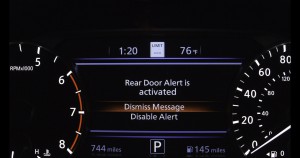
Nissan's Rear Door Alert system uses the horn to sound an alert to remind the driver to check the back seat.
The record heat scorching the country has been blamed for a series of devastating wildfires and other natural disasters, while contributing to what is on pace to become a record year for heatstroke deaths among children left in hot cars.
As July draws to a close, authorities have so far counted 29 child heatstroke deaths, a figure expected to soon surge pass the annual average of 37. Heatstrokes are not only the number one cause of non-crash vehicular deaths among children 15 years of age and younger, but also one of the most preventable. That’s led to a bipartisan push for new legislation on Capitol Hill, while several automakers have begun taking steps that could lower the deadly toll.
“No one thinks a hot car tragedy can happen to them or their family and that is why these tragedies continue to happen,” said Janette Fennell, founder and president of the nonprofit child safety organization KidsAndCars.org.
On rare occasions, authorities have accused parents of intentionally leaving a child in a hot car, in some cases simply while running errands, in other instances with more deadly intent. Georgia’s Justin Ross Harris was convicted of murder in December 2016 in a highly publicized case in which he was accused of intentionally leaving 22-month-old son Cooper in a hot car in June 2014.
(Technology available to end child heatstroke deaths now. Click Here for the story.)
But in most cases, the conclusion is that a parent or caregiver might have gotten distracted. Experts say it is far easier to happen than it might seem. A year ago, infant Josiah Riggins was left in his parents’ car for hours, apparently forgotten by his father, even though he drove from their suburban home to a local church twice.
Marlene Mendoza realized just how easily that might happen a couple years back when, she said, “I accidentally left a pan of lasagna in the back seat of my car overnight. The worst thing was the car smelled for days,” added the mother of three, who was pregnant at the time, “but it made me ask myself, ‘What if I left something far more important back there?’”
That led the Nissan engineer to explore ways to alert parents if they did leave a child behind in their car. The Japanese automaker launched its Rear Door Alert system on its 2018 Pathfinder SUV and will be adding it as standard equipment on eight more models, with the goal of having it on all Nissan products with back seats by 2022.
General Motors actually was first to come up with a Backseat Monitor system which it has rolled out on a wide range of vehicles sold in the U.S. If the rear doors are opened at some point, it will beep and light a dashboard alert reminding a driver to check the back seat the next time the vehicle is shut off. The Nissan system goes a step further, also sounding a distinctive alert on the vehicle’s horn.
Hyundai, meanwhile, launched its own alert system this month on the updated 2019 Santa Fe SUV. The Korean carmaker’s system relies on a motion sensor to detect whether someone is in the back seat. It can operate for up to 24 hours after a vehicle is shut off – an important development because as many as a third of the kids killed in hot car incidents actually entered the vehicle on their own but then couldn’t climb back out. And Hyundai’s high-tech approach also can send an alert to a designated smartphone.
Whether the motion sensor will prove effective remains to be seen. Several automakers had hoped to use high-tech solutions – GM exploring the idea of a system sensitive enough to detect a child’s heartbeat in a closed car – but they failed to be reliable enough.
But automakers continue to press for solutions, in part because they sense that regulators are finally ready to act.
“A simple sensor could save the lives of dozens of children killed tragically in overheated cars each year, and our bill would ensure such technology is available in every car sold in the United States,” Sen. Richard Blumenthal, a Connecticut Democrat, said when he signed on as co-sponsor of one measure introduced in Congress last year.
(Click Here to see more about Nissan’s Rear Door Alert system.)
With solid bipartisan support – despite the generally anti-regulatory direction taken by the Trump Administration and the Republicans – the Hot Cars Act would require alert systems similar to what Nissan and GM have developed.
“You have a reminder to put on your seat belt, take your keys from the ignition and that you’ve left your headlights on,” said KidsandCars’ Fennell. “Who decided that it’s more important not to have a dead car battery than a dead baby?”
Automakers aren’t the only ones trying to address the problem. Several brands of child car seats, including those sold by Evenflo and Cybex, have alert systems built-in. Those two brands, owned by Goodbaby International, will chime when a car’s ignition is turned off, alerting parents to look behind. They can also send out a smartphone alert.
Despite the development of such systems, experts warn that 2018 is on track to see a record number of child heatstroke fatalities. The previous high was recorded in 2010 when 49 children died. More than 800 kids have died since 1990, according to groups that track the problem.
With plenty of glass to magnify the sun’s rays, a motor vehicle’s interior can heat up rapidly. The Weather Channel, which has developed the “Scorching Car Scale,” noted that a car parked outside on an 86-degree day can reach 105 within 10 minutes and 120 degrees after a half-hour.
Not surprisingly, heatstroke is a particular problem in Sunbelt states like Florida and Texas. Arizona has one of the highest rates for such tragedies in the U.S., 18.1 per 1 million residents, according to NoHeatStroke.org. But experts say they have recorded deaths in every state since data has been tracked. Even on a relatively mild day, they warn, a vehicle sitting out in the open sun can quickly warm insider to temperatures fatal for young children – who overheat far faster than adults.
(Save your child. Look back to see if a youngster has been left behind. For more tips, Click Here.)
So, even in milder climates and conditions, organizations like KidsandCars and NoHeatStroke warn that parents and caregivers will need to stay alert.



Why can’t one of the OEM’s just develop a weight sensor similar to what is used in the front seats that activates the air bag? Clearly the weight sensor would have to be adjusted to register that of a child but it’s got to be possible since the same thing is done for air bags.
The most reliable add-on solution is Made in America: Never Forget Us! (www.never4get.us)